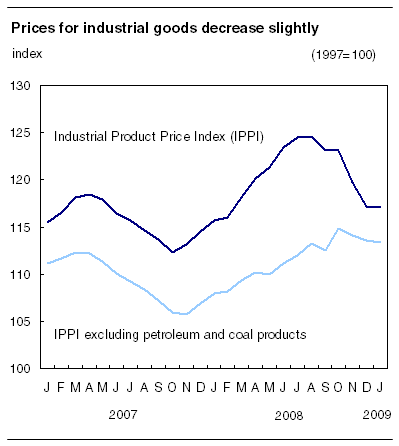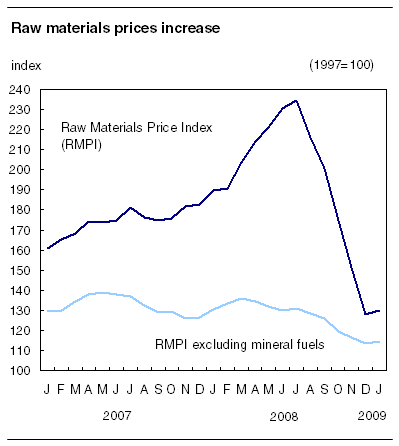Common menu bar links
Industrial product and raw materials price indexes
Archived Content
Information identified as archived is provided for reference, research or recordkeeping purposes. It is not subject to the Government of Canada Web Standards and has not been altered or updated since it was archived. Please "contact us" to request a format other than those available.
The Industrial Product Price Index (IPPI) declined 0.1% in January compared with December, while the Raw Materials Price Index (RMPI) rose 1.4%. The strong downward movement registered by these two indexes during the previous two months halted in January, with petroleum prices strengthening on world markets.
Chart 1

The IPPI decreased 0.1% in January, stabilizing after declines of 2.8% in November and 2.1% in December. Prices for petroleum and coal products increased 1.6%, after registering five substantial monthly declines in a row.
Excluding petroleum and coal products, the IPPI fell 0.2%, a third monthly decrease following declines of 0.6% in November and 0.4% in December. Of the 20 major groups, 12 posted a price decrease, notably motor vehicles and other transport equipment (-0.4%), pulp and paper products (-1.0%), and lumber and other wood products (-1.5%). These three product groups were sensitive to the change in the Canadian dollar in relation to its US counterpart.
The Canadian dollar rose 0.7% against the US dollar in January. Some Canadian producers who export their products to the United States are generally paid in prices that are fixed in US dollars. Consequently, the relative weakness of the US dollar in relation to the Canadian dollar had the effect of lowering their Canadian dollar equivalent prices. If the exchange rate used to convert these prices had remained unchanged, the IPPI would have risen 0.1% compared with December, instead of declining 0.1%.
12-month change: Industrial Product Price Index continues to post slower growth
Year over year, the IPPI rose 1.2% in January, which marks a continuing deceleration in the growth of the index. This was the weakest advance in the index in 10 months.
Note to readers
The Industrial Product Price Index (IPPI) reflects the prices that producers in Canada receive as the goods leave the plant gate. It does not reflect what the consumer pays. Unlike the Consumer Price Index, the IPPI excludes indirect taxes and all the costs that occur between the time a good leaves the plant and the time the final user takes possession of it, including the transportation, wholesale, and retail costs.
Canadian producers export many goods. They often quote their prices in foreign currencies, particularly for motor vehicles, pulp and paper products, and wood products. Determining the full effect of fluctuating exchange rates on the IPPI is a difficult analytical task. However, it should be noted that many prices collected to calculate the IPPI are quoted in US dollars and then converted into Canadian dollars. Therefore, a rise or fall in the value of the Canadian dollar against its US counterpart affects the IPPI.
The conversion of prices received in US dollars is based on the average monthly exchange rate (noon spot rate) established by the Bank of Canada, and it is available on CANSIM in table 176-0064 (series v37426). Monthly and annual variations in the exchange rate, as described in the text, are calculated according to the indirect quotation of the exchange rate (for example, CAN$1 = US$X).
The Raw Materials Price Index (RMPI) reflects the prices paid by Canadian manufacturers for key raw materials. Many of these prices are set in a world market. Unlike the IPPI, the RMPI includes goods not produced in Canada.
This slowing in the growth of the IPPI in January was mainly caused by a substantial 28.4% drop in the prices for petroleum and coal products compared with a year ago, the largest annual decline since December 2001.
The prices for products other than petroleum and coal were up 5.0%, representing a third consecutive slowing in growth. Contributing the most to the increase in the IPPI were motor vehicles and other transport equipment, as well as pulp and paper products, pushed up in part by the depreciation of the Canadian dollar in relation to its US counterpart.
The Canadian dollar lost 17.5% of its value compared with January 2008, and if the direct effect of the exchange rate had been excluded, the IPPI would have declined 4.9% instead of increasing 1.2%.
Raw Materials Price Index posts a turn around after five substantial declines in a row
The RMPI posted a monthly increase of 1.4% in January, compared with a substantial decline of 15.4% in December. Despite this rebound in prices, the level of the index remained 14.2% lower than in November 2008, owing to the size of December's decline.
Chart 2

Prices for mineral fuels rose 2.8%, a marked change from the 29.9% drop in December and the substantial declines registered since August 2008. Excluding mineral fuels, the RMPI rebounded with a 0.6% increase, compared with the strong declines observed in the last five months of 2008. Apart from mineral fuels, vegetable products made a modest contribution to the rise in the RMPI.
From January 2008 to January 2009, raw materials continued and accelerated their downward movement, falling 31.6%, compared with December's decrease of 29.9%. The drop in raw material prices was attributable to the strong 48.5% decline for mineral fuels and, to a lesser extent, to decreases in prices for non-ferrous metals (-35.6%) and vegetable products (-12.0%).
Available on CANSIM: tables 329-0038 to 329-0049 and 330-0006.
Definitions, data sources and methods: survey numbers, including related surveys, 2306 and 2318.
The January 2009 issue of Industry Price Indexes (62-011-XWE, free) will soon be available.
The industrial product and raw material price indexes for February will be released on March 31.
For more information, or to enquire about the concepts, methods or data quality of this release, contact Client Services (613-951-9606, fax: 613-951-2848, prices-prix@statcan.gc.ca), Prices Division.
Table 1
| Relative importance | January 2008 | December 2008r | January 2009p | January 2008 to January 2009 | December 2008 to January 2009 | |
|---|---|---|---|---|---|---|
| (1997=100) | % change | |||||
| Industrial Product Price Index (IPPI) | 100.00 | 115.7 | 117.2 | 117.1 | 1.2 | -0.1 |
| IPPI excluding petroleum and coal products | 94.32 | 108.0 | 113.6 | 113.4 | 5.0 | -0.2 |
| Aggregation by commodities | ||||||
| Meat, fish and dairy products | 5.78 | 108.2 | 112.8 | 112.6 | 4.1 | -0.2 |
| Fruit, vegetables, feeds and other food products | 5.99 | 115.7 | 115.3 | 116.3 | 0.5 | 0.9 |
| Beverages | 1.57 | 125.6 | 127.3 | 127.2 | 1.3 | -0.1 |
| Tobacco and tobacco products | 0.63 | 218.1 | 222.2 | 222.5 | 2.0 | 0.1 |
| Rubber, leather and plastic fabricated products | 3.30 | 116.5 | 122.3 | 121.9 | 4.6 | -0.3 |
| Textile products | 1.58 | 99.3 | 103.3 | 103.5 | 4.2 | 0.2 |
| Knitted products and clothing | 1.51 | 104.8 | 104.8 | 104.9 | 0.1 | 0.1 |
| Lumber and other wood products | 6.30 | 81.1 | 84.7 | 83.4 | 2.8 | -1.5 |
| Furniture and fixtures | 1.59 | 121.1 | 124.0 | 124.1 | 2.5 | 0.1 |
| Pulp and paper products | 7.23 | 103.0 | 116.1 | 114.9 | 11.6 | -1.0 |
| Printing and publishing | 1.70 | 115.9 | 125.1 | 125.0 | 7.9 | -0.1 |
| Primary metal products | 7.80 | 136.2 | 121.1 | 121.7 | -10.6 | 0.5 |
| Metal fabricated products | 4.11 | 124.9 | 136.4 | 136.2 | 9.0 | -0.1 |
| Machinery and equipment | 5.48 | 104.2 | 112.6 | 112.4 | 7.9 | -0.2 |
| Motor vehicles and other transport equipment | 22.16 | 86.2 | 99.4 | 99.0 | 14.8 | -0.4 |
| Electrical and communications products | 5.77 | 89.4 | 97.1 | 97.0 | 8.5 | -0.1 |
| Non-metallic mineral products | 1.98 | 125.1 | 126.7 | 127.7 | 2.1 | 0.8 |
| Petroleum and coal products1 | 5.68 | 259.4 | 182.8 | 185.7 | -28.4 | 1.6 |
| Chemicals and chemical products | 7.07 | 131.5 | 139.0 | 138.5 | 5.3 | -0.4 |
| Miscellaneous manufactured products | 2.40 | 116.6 | 123.4 | 123.8 | 6.2 | 0.3 |
| Miscellaneous non-manufactured products | 0.38 | 408.6 | 299.3 | 292.8 | -28.3 | -2.2 |
| Intermediate goods2 | 60.14 | 121.1 | 120.5 | 120.2 | -0.7 | -0.2 |
| First-stage intermediate goods3 | 7.71 | 150.4 | 125.7 | 124.6 | -17.2 | -0.9 |
| Second-stage intermediate goods4 | 52.43 | 116.7 | 119.8 | 119.6 | 2.5 | -0.2 |
| Finished goods5 | 39.86 | 107.7 | 112.2 | 112.5 | 4.5 | 0.3 |
| Finished foods and feeds | 8.50 | 116.2 | 119.2 | 119.2 | 2.6 | 0.0 |
| Capital equipment | 11.73 | 95.8 | 106.8 | 106.5 | 11.2 | -0.3 |
| All other finished goods | 19.63 | 111.1 | 112.5 | 113.2 | 1.9 | 0.6 |
Table 2
| Relative importance | January 2008 | December 2008r | January 2009p | January 2008 to January 2009 | December 2008 to January 2009 | |
|---|---|---|---|---|---|---|
| (1997=100) | % change | |||||
| Raw Materials Price Index (RMPI) | 100.00 | 189.8 | 128.0 | 129.8 | -31.6 | 1.4 |
| Mineral fuels | 35.16 | 318.0 | 159.2 | 163.7 | -48.5 | 2.8 |
| Vegetable products | 10.28 | 129.1 | 108.6 | 113.6 | -12.0 | 4.6 |
| Animals and animal products | 20.30 | 102.8 | 111.4 | 110.3 | 7.3 | -1.0 |
| Wood | 15.60 | 82.6 | 81.7 | 80.9 | -2.1 | -1.0 |
| Ferrous materials | 3.36 | 152.8 | 144.8 | 146.4 | -4.2 | 1.1 |
| Non-ferrous metals | 12.93 | 213.3 | 136.5 | 137.3 | -35.6 | 0.6 |
| Non-metallic minerals | 2.38 | 160.5 | 173.4 | 175.4 | 9.3 | 1.2 |
| RMPI excluding mineral fuels | 64.84 | 130.5 | 113.5 | 114.2 | -12.5 | 0.6 |

